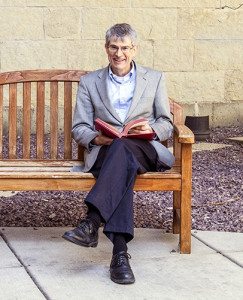New opera sheds light on Artemisia Gentileschi, one of the Baroque’s most respected female painters
By Michael Muckian
Artemisia, the recently completed opera by the University of Wisconsin’s Laura Elise Schwendinger, has been scheduled for its world premiere performance January 7 in New York City as part of Trinity Church Wall Street’s 2016-2017 performance season.

Laura Schwendinger
A concert performance from the opera about 17th Century Italian Baroque painter Artemisia Gentileschi by Schwendinger, professor of music composition at the UW’s Mead Witter School of Music, will be part of the ensemble’s Time’s Arrow Festival. Schwendinger’s composition will be one of four world premieres to be performed during the free concert series. Schwendinger has written large vocal works before, but this is her first opera.
“This is a magnificent group of musicians, and maestro Julian Wachner is a gifted composer and conductor who is always challenging himself,” Schwendinger said. “It is an honor to have my work presented by them.”
The annual festival, which features music spanning three centuries, will take place at St. Paul’s Chapel, located at 209 Broadway. The concert series will help celebrate the 250th anniversary of St. Paul’s, Manhattan’s oldest church whose doors first opened October 30, 1766.
The January performance of Artemisia, co-commissioned by New York’s Trinity Wall Street Novus and San Francisco’s Left Coast Chamber Ensemble, will feature mezzo-soprano Patricia Green as Artemisia, Marnie Breckenridge as Susanna, baritone Andrew Garland as Tassi and tenor Andrew Fuchs as Tomasso. The performance is free.
“The story of Artemisia hit me when I was an artist-in-residence in Rome (in 2009),” said Schwendinger, who herself paints. “I visited a lot of galleries and was struck by her works, including “Judith Slaying Holofernes.” There weren’t very many acclaimed women painters at the time.”
Schwendinger and librettist Ginger Strand, essayist and author of The Brothers Vonnegut: Science and Fiction in the House of Magic (Farrar, Straus & Giroux 2015), hope that Artemisia will change the historical perception of Gentileschi, who lived from 1593 to 1656.
Schwendinger, the first composer to win the American Academy in Berlin Prize, read a biography of the artist, who like many of her contemporaries worked in the style of Caravaggio. It was during discussions with Strand, a former college art history major who was aware of Artemisia and her work, that the idea of an opera based on her life began to gel.
“This is the kind of project that mixes my love of art with the story of an important women artist,” Schwendinger says. “It’s a nice connection.”

Artemisia Gentileschi – Self-Portrait as the Allegory of Painting. Public Domain.
While Gentileschi holds the high honor of being the first female member of Florence’s prestigious Accademia di Arte del Disegno and was a respected artist in her time, history books remembered her more as a teenage victim of rape by her tutor, fellow artist Agostino Tassi.
Following the assault and the older Tassi’s ultimate failure to marry the 16-year-old girl as promised, Gentileschi’s father, the Tuscan painter Orazio Gentileschi, pressed charges against Tassi for taking his daughter’s virginity. The lawsuit, highly unusual for the time, resulted in long, protracted proceedings, during which Gentileschi was subject to gynecological exams and torture to verify her testimony.
The proceedings also revealed a plot by Tassi to murder his wife, adding to the sensationalism of the lawsuit. Tassi eventually was sentenced to one year in prison, but never served any time.
Gentileschi would go on to have a long and successful career, rare for a female painter in her time. But later generations would obscure her contributions to the Baroque period, and some of her work was even attributed to other artists.

Artemisia Gentileschi – Judith Beheading Holofernes. Public Domain.
In recent years, that perception has begun to shift back, with Gentileschi again credited as one of the period’s greatest painters. Schwendinger hopes her opera can spread Gentileschi’s story, further righting the wrong done to her by historians.

Artemisia Gentileschi – Clio, The Muse of History. Public Domain.
Born in Mexico City to a pair of U.S. foreign exchange students and raised in Berkeley, California, Schwendinger began making up melodies at age 4 and playing the flute at age 8.
When she applied to the San Francisco Conservatory of Music to study flute, her application included several compositions as well, which caught the eye of composer John Adams, best known for his operas Doctor Atomic and Nixon in China. He invited her to study composition with him, and she afterward went on to receive both her master’s degree and Ph.D. in music from the University of California-Berkeley, where she studied with her mentor and thesis advisor Andew Imbrie.
Her career has since seen her music played extensively both here and abroad, including at Carnegie Hall, Lincoln Center, Wigmore Hall in London and the Théâtre du Châtelet in Paris, and has been toured as well as recorded by some of the leading musicians of our time, including the singer Dawn Upshaw. She has been a professor at UW-Madison for more than a decade.
The University recently awarded her a $60,000 Kellett Mid-Career Award, a grant sponsored by the Wisconsin Alumni Research Foundation and awarded to nine other faculty members for the 2016–17 academic year.
Schwendinger also received $16,500 as part of OPERA America’s $200,000 Discovery Grants for Female Composers, awarded to seven women and seven opera companies, which she will use in addition to the Kellett Award to mount upcoming productions of Artemisia. The entire opera will be fully produced by the award-winning Left Coast Chamber Ensemble in San Francisco in 2018.
“I hope that Artemisia resonates with those there and beyond, but that is not something a composer can predict,” Schwendinger said. “The composer creates the best art she can and hopes that it will mean something to the public and move the people who experience it.”







